Nick Park interview: Early Man, Aardman, The Wrong Trousers, The Beano
We chat to the multi-Oscar-winner Nick Park, about his first feature film as director in over a decade, Early Man...
Nick Park has more Oscars than I’ve got pairs of shoes. He’s created characters that mean something to a huge number of people. And yet when I told him, just before our interview, how much I’d enjoyed his new movie, Early Man, he looked taken aback. And then genuinely appreciative. I’m not sure why that should surprise me, given how much Park clearly sinks into his work. But also, the surprise that somebody had liked his movie seemed genuine. Pre-release nerves are funny things.
Still, as he stirred his freshly poured cup of ginger tea, he settled down for a chat…
I wrote on my notes after seeing this film that your film captures the spirit of Whizzer & Chips, Yonderland, Hot-Shot Hamish, Escape To Victory and Ray Harryhausen! Was that roughly where you were aiming?
[Laughs] That’s alright! I haven’t thought quite like that. I guess there are influences from those comics, though. I didn’t really know Whizzer & Chips very well, though.
It was the comic that split its readers up, where one part of the comic was constantly at war with the other.
I remember that! I’m definitely influenced by the Beano and Dandy. Bully Beef & Chips!
Well, our website is very much influenced by the language of D C Thomson. But do you think that comics culture of the 50s through to the 80s, of very British comic strips, is being lost?
Yeah, yeah. I saw the recent design for Dennis the Menace, which wasn’t the Dennis the Menace that I grew up on. He looks a lot cooler in the new design. He was never cool, though, he was a menace, and I loved him! I loved the old drawing. I’ve got a signed thing by the original artist!
I know what you mean, though. I often thought the band of cavemen [in Early Man], they stand together as a group. I did think of The Bash Street Kids, they often came to mind. That bunch of misfits all hanging around together, on street corners, wondering what to do. This bunch of cavemen were all together all the time.
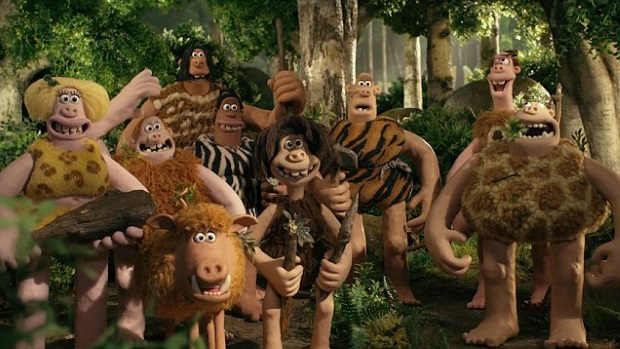
The obvious thing for you to do would be lots of Wallace & Gromit sequels, and go and live on an expensive yacht. But I came in while this was being made, and you seemed invigorated by the idea of bringing a whole new bunch of characters together from scratch, for the first time since Chicken Run. Was that the thing for you? The character challenge again?
That is the big thing about it. The bit I particularly enjoy, and find a challenge at the same time, is new characters. And creating new characters. For a new story, it’s quite hard setting up a brand new universe with a new set of characters. Who are they? How do they interact? What are their problems? Where have they come from? I don’t think I have answers to all of those questions yet!
But is it a case of it’s important to ask the questions when developing, even if you don’t know the answer?
Yeah, yeah. That’s part of the rigour of writing I think.
Can you take us through the first ten minutes of the film, then, which you’ve described as a nightmare to get storyboarded and right? Is there a specific difficulty? Because you do set up an awful lot, and kill the dinosaurs, and kill someone off!
[Laughs] It’s quite a tricky setup. We always had that problem from the first concept. From the offset, when me and Mark Burton started chatting about it and kicking it around, there was always this idea of a bunch of cavemen who invent the game of football. But the idea that the people who invented the game can’t win it. A self-deprecating joke about England! But we always had this idea that the guys who invented it have to become the underdogs. That was a hurdle to get through in a story very quickly.
Is it the speed of getting that setup done that’s the killer?
Yes, because it’s a long first act. Normally, in the first act, the main character leaves the ordinary world for the special world. Goes to the special world and then comes back again, after having a whole adventure in the special world.
Is that all trickier than setting up Chicken Run? Because that felt instantly more contemporary? That you didn’t have to establish time as much in that one, but you do here?
No. I remember that was always the question. How do you get into the story? In all feature films, and it’s the same in a scaled down way for short films, the three act structure idea. I remember DreamWorks always talking about how the most important bit is the first ten minutes of a movie. That’s when you have to get everybody’s interest. And with this as well… actually it was the same on Curse Of The Were-Rabbit too. How do you set it up the most efficiently?
That’s why most animated films start off with voiceover of the main character. The Croods, for instance. They often start with a ‘hi, this is my world, this is my family, but hey, now into the adventure’. They do an awful lot of that spadework in just dialogue.
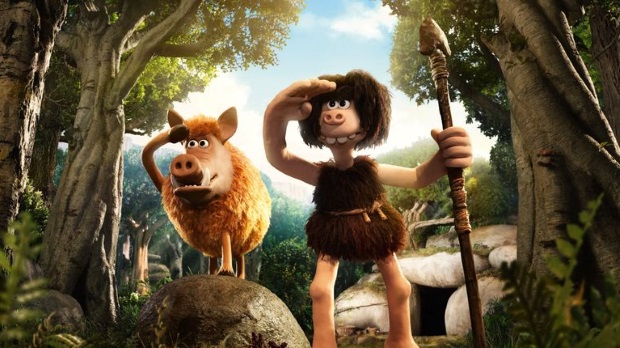
You resist breaking the fourth wall in Early Man, though? Even in moments where your characters are effectively staring down the lens of the camera.
That’s right.
They are looking straight at us, too. It’s almost like a Robert De Niro in Cape Fear moment.
Yeah! The fourth wall is important. It’s to do with convention I guess. It’s tempting to make format jokes, about the format itself. We did it in one of the trailers, though. You think it’s film music, and it’s the cavemen that are making the music!
An odd question, perhaps, but did you enjoy making this film? The later DreamWorks stuff that you did, you’ve said that it wasn’t a case of not enjoying it, but that you were combatting notes. This, though, was your world. Even though you weren’t down on the animation floor as much, did you enjoy it?
I did, yeah. I did feel at the helm. And that’s why I wanted to direct it on my own really. I wanted to be at the reins more, and I wanted to try that out. You have to restructure to do that. In a way, when there were two of us directing, I had more time on the floor with the animators. Now I had two deputies, animation directors on the floor. I was in story meetings, editing, recording actors, briefing, all sorts. I was briefing directors of animation more than animators, although I did a lot of acting stuff out on video. To put across what I was after, the timing, the size of the gag of whatever. That was all very important to somehow convey what I was after.
Even though I was at the top of this pyramid, I still feel hands on, and that creates quite a rod for my back really. I like to design the characters and be very hands on with that. Even though we have a great team of people who make them nicer, and ready for mould-making. But you make that rod for your back if you want that involvement, because everyone’s waiting on you. It’s feeding the machine! Quite full on.
I’m the nerd who sits through end credits, and I saw that Gareth Malone pops up in the names this time.
[Grins] That’s right!
He was conducting the football chants?
Yeah, yeah. He kindly came to do that!
Did you take him to Bristol City to do that?
Yeah, it was at Ashton Gate. We had 750 people, who made quite a noise actually.
That, presumably, was the way to legitimately do it, though. Otherwise, you’re cheating.
Yeah, the sound designer has been on all my films. And obviously you can source those sorts of things, but he just wanted it real. So we just recorded it for real! There were specific things we wanted too, and certain chants!
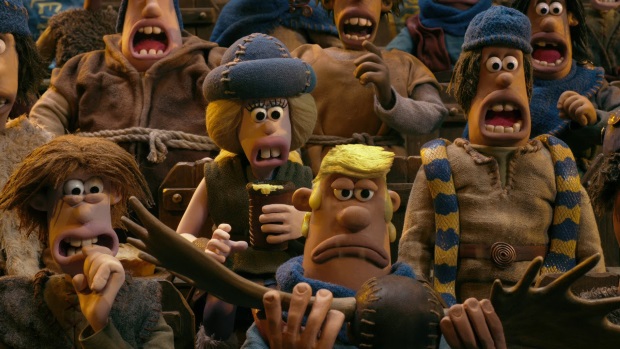
One of the things I noticed when reading the credits was that Aardman, even though it’s much bigger than it was, is still relatively small. Sit through the end credits of a Pixar movie and it feels like there are thousands of names. Here, I counted more model makers than animators. You talked about not being on the floor as much – which is generally where I’d perceive you to be…
I am normally. I do miss that.
… so did you have the size of team to still make it manageable, and to ensure you still felt in control?
It was a very big team. 35 to 40 sets, and as many animators. There is a certain size that becomes… I don’t know, each film has its own correct number. This was a very ambitious project, and it grew, and it became an epic! It’s interesting that all the principal animation and character work is stop frame, but we do cross over to digital. Mainly for background characters. We actually couldn’t afford the rendering time to have the detail, so we had to keep some characters out of focus, or in very wide shots, because there wasn’t the time of the cost available to have detailed CG.
Who works out, then, the maths of a football’s gravity, when you’re not using CG?
We try to keep it as stop frame as we could. In a way, and this gets onto perhaps one of the biggest challenges of the whole film. As an underdog prehistoric sports movie…
That’s a category!
It’s not the clash of two civilisations, it’s the clash of two genres! We realised they are two very different genres that have very different structures and archetypal things going on. But my vision for the whole film was that once you find out about football, and it is in the beginning gladiatorial. And I was inspired by Gladiator. How can we execute football in a way that’s as exciting as the main scenes in Gladiator, when he comes into the main arena?
That was my kind of ambition. The euphoria of the crowd and everything. We worked on how can we execute it, because football matches, the way they’re shot, are very much the camera above. Not that cinematic. But we had the cinema to our advantage. To get the camera in there and have all sorts of angles. But obviously limited, because when you have characters who are all about a foot high, then that makes the pitch 30 feet long. Which means you can’t reach the characters! Six feet in and you can’t reach them! So any background models have to be digital, and it was cheaper to do them that way.
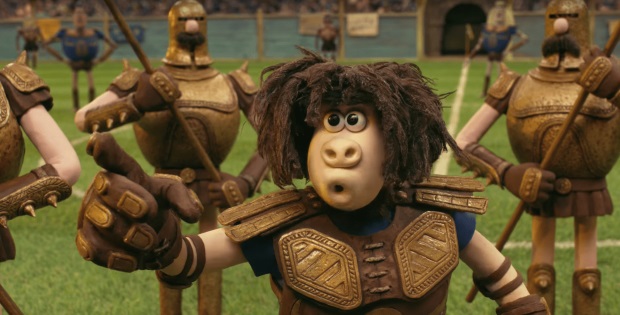
I’ve just been in with Eddie Redmayne, and he had no idea that you cast him partly off the back of Black Death! And that you cast Tom Hiddleston after seeing clips of him doing impressions on The Graham Norton Show.
Yeah!
I’m curious, then! What films do you watch when you go home on a Friday? Are you like many of us, getting a takeaway in and digging out a movie?
Yes!
What kind of stuff do you watch, then?
It varies! I just happened to catch Black Death on Channel Four one evening. One of things is you have your radar when you’re casting. The great thing is that there’s TV and there’s YouTube, and you can just listen out. I’m always listening, to the radio too. That’s how you find people. Obviously, you go through an agent as well, but I’ve always got my feelers out.
I saw Eddie, and I was after a sort-of dishevelled teenager, and he was exactly that. I loved that vulnerability he had, and that understatedness about him.
Plus he was being beaten up by Sean Bean.
Yeah, yeah. Right! Obviously I was after the comedy version of that! But as soon as Eddie came in, he agreed to come in and test for it, he asked how old we thought Dug was. 15 maybe? And then he went to 15.
A subject change, if I may.
I’ve always wanted to ask this. I watched the documentary on this, but I still can’t fathom it. How on earth did you do the train chase in The Wrong Trousers?
Oh gosh, yeah!
Well, back then, none of us knew what we were doing. Not that we do now! But there was a small team of us. Dave Riddett, who’s been with us for years. He’s really into effects as well. I wanted it to be the fastest thing you’ve ever seen in stop frame. We ended up using a similar technique to Tom & Jerry really. Repeated backgrounds. We built a living room wall, about the length of this room, about 20 to 30 feet. And we had the track. We wanted lots of blur. It was partly from seeing the chase along the mines in Indiana Jones.
Temple Of Doom?
Yeah. We used a normal double-O gauge railway. We had to go out and buy a train to scale, and change the body of it so it looked right for the film. And put the penguin in there, and Gromit. And we attached, off screen, the train to the camera dolly, so that the camera is fixed with the train.
Every time we animated the penguin or Gromit, we then when taking the frame… it wasn’t stop frame as much as go motion. We then pushed the camera along, and at a certain point we slightly progressed each frame, and took the picture on a slightly slower shutter. Which meant the background blurred. It was non-computerised, it was all done by hand.
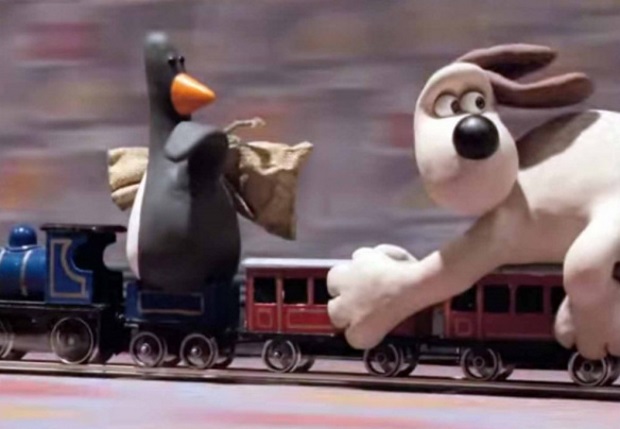
Do you go all Sam Raimi? The stuff you invented on the early stuff you still use?
Yeah, we do that. We used the same technique in A Close Shave. Were-Rabbit, Wherever we could, we used that same technique.
Clearly, then, you’ve created these new characters for Early Man, and Aardman owns then. There’s no argument there. But what do you want to do with them next? They lend themselves to more films, to television. Have you thought what comes next?
No, I haven’t. My brain has been just so full of trying to launch this ship, and I feel like I’ve been in the engine room for the past two years. It’s an interesting idea, doing another one. I’m not sure I could myself.
But you yourself are still impassioned to make films?
Yeah. After a big one like this, my dream is to do something a bit small. Work with three characters again!
Nick Park, thank you very much.